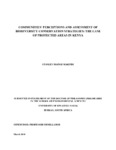| dc.description.abstract | Protected areas in Kenya constitute 7% of the total land area with over 75% of wildlife in the
country being found on private or communal land. With one of the highest population growth
rates in the world and facing a range of development issues with limited resources, one of the
greatest challenges in Kenya is reconciling and sustaining economic development with
biodiversity conservation and sharing the costs and benefits of conservation between individuals,
state and the general community. The study was informed by the relevant literature and the
researcher’s fieldwork which was conducted in 2008 in three categories of protected areas under
different governance types and primary management objectives in Kenya (Lake Nakuru National
Park – government managed, Kimana Community Wildlife Sanctuary – communally managed,
and Kedong Game Ranch – privately managed). The research examined the general issues of
how local communities in Kenya have embraced different biodiversity conservation strategies. A
major emphasis was on identifying those factors influencing their attitudes towards conservation
approaches and their participation in conservation management institutions. At issue was
whether support for a particular conservation strategy is primarily a function of communities’
experiences with biodiversity decline or their relationship with the conservation authorities. The
research employed both qualitative and quantitative techniques in gathering the data. A total of
270 community respondents and 45 staff respondents were interviewed. Several demographic
and socio-economic characteristics of the local people that include age, gender, educational level
and location, amongst others, were found to significantly influence the attitudes of the local
people towards the protected areas conservation activities. The direction of the influences
(whether positive or negative) depended on the management category of the particular protected
area. The general findings of the study suggest that although local people appreciate the crucial
value of biodiversity and the role of protected areas in conserving it, there is some evidence of
resentment towards some management activities of the protected area regulators. Negative
attitudes were attributed to perceived problems of living next to the protected areas such as lack
of involvement of the local people in the management of the protected areas, restrictive access to
and use of resources from the protected areas, harassment by the conservation enforcing agents,
conflicts with wildlife and lack of compensation for damages and losses incurred. Widespread
support for the management activities was associated with perceived benefits to the local
populations such as support for educational programmes, social amenities, employment and
business opportunities. It is clear from this study that different rationales of conserving
biodiversity need to address the issue of protected area management in the context of sustainable
development through a combination of conservation strategies. | en_US |

